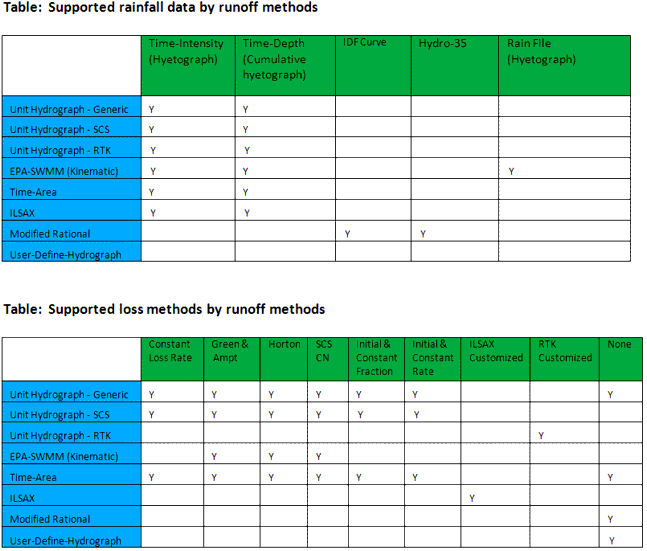Hydrology (Rainfall-Runoff) Solvers
There are two different types of solvers used in the Bentley storm and sanitary sewer products. There are the hydraulic solvers which determine the flows in the conduit and channel networks (implicit, explicit, GVF-convex and GVF-rational). In model runs that perform rainfall-runoff calculations, there are also hydrology solvers which covert rainfall (generally on a catchment) to runoff.
While there are a large number of rainfall-runoff methods supported in the Bentley products, they can be grouped as to whether they were developed by Bentley or were extracted from SWMM. Within each runoff method, there are methods to determine loss, which refers the rainfall that does not become runoff but infiltrates into groundwater, and hydrograph, which refers to how the rainfall (that is not lost) is converted into a hydrograph. In some methods, like RTK, the loss and runoff calculations are implicitly combined.
Data entry for the hydrologic solvers depends highly on which solver is to be used. Some require that the loss and hydrograph methods be specified while others implicitly contain the methods. The list below shows which methods are needed for each method to determine runoff.
SWMM Hydrology
Bentley Hydrology
All of the hydrologic methods can be used with any of the non-steady state hydraulic numerical solvers. For the steady runs using the GVF rational solver, the rational method must be used while for steady runs with the steady state GVF-convex solver, the user cannot use catchment hydrology.
In general, for long term continuous simulation, the SWMM hydrology methods should be selected because they work more effectively with long term rainfall data.
In general, all of the catchments should use either Bentley hydrology methods or SWMM hydrology methods and not mix them in a given run. When the SWMM based hydrology solvers are used, the same loss method must be used for all catchments and the loss method is specified in the Calculation options rather than as a catchment property.
The two RTK methods use different internal solvers so a user should decide beforehand which one to use and not try to switch back and forth. Unlike the other hydrology methods, the SWMM RTK method is applied to nodes such as manholes. It is generally more appropriate for I/I studies.

